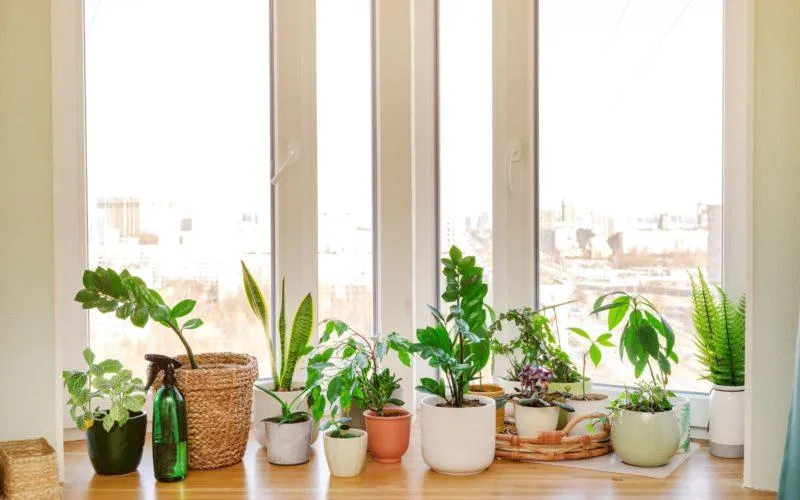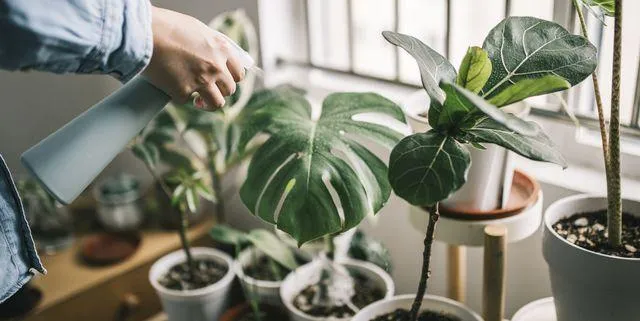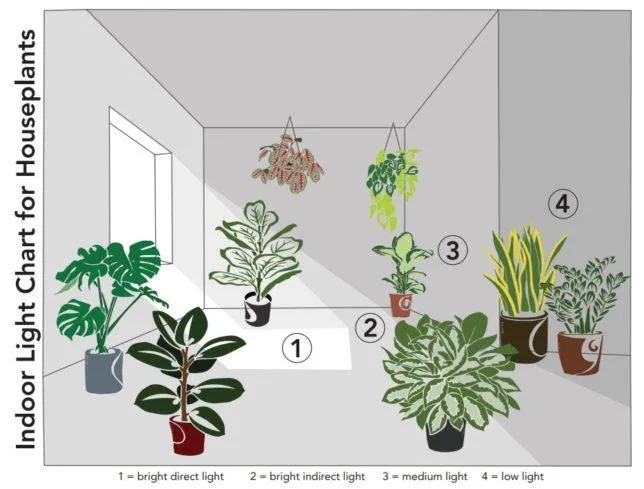Choosing the Best Houseplants for Low-Light Conditions
If you live in an apartment or home with limited natural sunlight, you may be wondering which types of plants can thrive without direct sun exposure. From my experience as an avid gardener, there are several great options for low-light plant lovers. In this article, I will discuss some top-performing houseplants that can do well even in shady spots.
ZZ Plant (Zamioculcas zamiifolia)
The ZZ plant is one of the toughest houseplants out there. It has earned the nickname of “the zombie plant” for its ability to survive severe neglect. ZZ plants can go weeks without water and flourish in very low light. With waxy dark green leaves, it adds dense foliage to any area. I keep a ZZ plant in my basement, which gets bright indirect light, and it’s grown significantly over the past year with no issues. These plants are virtually impossible to kill, making them ideal for low-maintenance plant parents.
Snake Plant (Sansevieria trifasciata)
Another resilient option is the snake plant. These upright plants with sword-like leaves can tolerate very low light as well as infrequent watering. I have a snake plant situated about 10 feet back from a north-facing window, and it’s been thriving there for over 5 years with minimal care. Snake plants release oxygen at night, so they help purify the air even in low-light conditions. They’re available in various sizes and varieties, from tiny to towering, so you can find one that fits your space well.
Pothos (Epipremnum aureum)
Pothos plants, or devil’s ivy, are incredibly versatile when it comes to light requirements. Their trailing vines can grow in bright light but also do well in low-light areas several feet back from windows. Pothos look beautiful trained up a moss pole or dangling over the edge of a bookshelf. Because of their ability to survive on very little light, pothos make great bedroom or office plants. I have a massive golden pothos that’s been gracing my dining nook for years despite only getting dappled morning sunlight from a nearby window.
Chinese Evergreen (Aglaonema modestum)
For colorful foliage options in low light, Chinese evergreens can’t be beat. These plants come in an array of vivid leaf patterns ranging from dark emerald to pinks and reds. They prefer medium to low light and average home temperatures. Basically, as long as they get indirect sunlight, Chinese evergreens will thrive. I keep one on my kitchen counter, and its vibrant leaves add a nice pop of color to that low-light area. Plus, these compact plants come in varied sizes, so you can fit them almost anywhere in your home.
Cast Iron Plant (Aspidistra elatior)
Believe it or not, the cast iron plant lives up to its name by tolerating very low light conditions. I’ve even seen these plants used as floor plants under tables due to their ability to handle limited sun exposure. Aside from thriving in shady spots, cast iron plants are renowned for being extremely hardy and tolerant of neglect when it comes to watering. These undemanding plants just keep growing with infrequent care. Their sword-like variegated or solid green leaves add an elegant, fern-like texture to any corner.

Peacock Plant (Calathea makoyana)
While peacock plants prefer medium to high humidity levels, they can still do well in low light as long as the air isn’t too dry. The brightly patterned ruffled leaves really stand out and add vibrant colors to an area. You may notice these plants curling up their foliage at night – it’s just their natural circadian rhythm at work. To keep yours looking its best in low light, run a humidifier nearby or mist the leaves regularly with distilled water. These eye-catching plants can beautify dim corners and tables while asking for minimal sun exposure.
Lighting Conditions to Simulate Sunlight
Another strategy for low-light gardeners is to supplement your plants’ environment with artificial lighting that can mimic natural sun exposure. Here are some top options:
Grow Lights
Full-spectrum LED or fluorescent grow lights are specifically designed to emit wavelengths of light that houseplants need to photosynthesize. You can hang single fixtures over individual plants or install multi-head setups for large collections. Leave lights on for 10-14 hours daily for maximum benefit. Shop for brands rated for indoor growing.
West-Facing Windows
- Position plants near west-facing windows to catch the lower-angle winter sunlight.
- Rotate plants occasionally so all sides get some light exposure.
- Move plants closer to the glass during sunny periods for added brightness.
Bright Indoor Spots
Places like bathroom windowsills, above kitchen sinks, and near skylights receive more ambient light, even on overcast days. Arrange your greenery in these sunnier indoor areas first before resorting to low-light zones.
Caring for Low-Light Plants
While low-light plants are very forgiving in terms of sunlight needs, they still require conscientious care to stay healthy:
Water Sparingly
With less intense light, these plants transpire less water through their leaves. Check soil moisture frequently and only water when the top inch is dry. Err on the side of letting soil dry out versus overwatering.

Fertilize Lightly
During their growing season (spring-fall), feed houseplants monthly with a diluted liquid fertilizer. But go easy on the nutrients, max once every 2 months in winter due to lesser light restricting growth.
Dust Leaves Regularly
Use a soft cloth to wipe down foliage at least biweekly to remove built-up debris from lower indoor air quality. Clean leaves allow for more efficient nutrient absorption and photosynthesis.
Prune to Encourage Bushiness
Periodically trim leggy vines and stems back to dense growth areas at leaf joints to maintain a full, rounded shape without lots of lanky branches. Most plants will rewarded you handsomely for the haircut with new shoots.
Reporting Larger Specimens Annually
Replant rootbound plants in fresh potting mix each spring for optimum vigor and bloom cycles for the upcoming year. Up-potting ensures proper drainage and room for root expansion despite lesser growgh potential in shadier spots.
With its incredible diversity of low-light loving plants, indoor greenery is totally accessible even for low-sunshine home and apartment gardeners like myself. With a little care and getting to know their preferences, you too can enjoy lush gardens indoors whatever the season may bring outdoors.
So in summary, I hope this comprehensive guide has shed light – pun intended! – on some of the best options if you want no-fuss houseplants that will survive and thrive without direct sunlight. Please let me know if you have any other questions! Happy planting.

Best Houseplants for Low Light Rooms
| Plant | Light Needs | Watering | Care Tips |
|---|---|---|---|
| Pothos | Low, Bright Indirect | Let Dry Between Waterings | Trim Leggy Vines, Increase Sun for Faster Growth |
| Snake Plant | Very Low, Any Light | Let Soil Dry Completely | Tolerates Neglect, Remove Dead Leaves |
| Philodendron | Low, Bright Indirect | Let Dry Slightly Between Waterings | Remove Dead Leaves, Propagate Cuttings for New Plants |
| Chinese Evergreens | Low, Bright Indirect | Let Dry Slightly Before Watering | Prune to Shape, Increase Sun for More Colorful leaves |
| ZZ Plant | Very Low, Any Light | Let Soil Dry Completely | Tolerates Neglect, Cut Back to Encourage Bushier Growth |
FAQ
-
Which houseplants can live without any direct sunlight?
Basically, the following plants can survive without natural light: pothos, snake plant, spider plant, peace lily, english ivy, philodendron, chinese evergreen, and ZZ plant. These plants are commonly known as “low light” plants.
-
How much light do low light plants need?
While low light plants can tolerate very dim conditions, they will grow and thrive better if they receive some indirect sunlight each day. Aim to position them near an east, west or south facing window so they get natural light for several hours. Otherwise, using a grow light a few hours daily may help.
-
Won’t plants die without any sunlight?
Surprisingly, no. Certain plant varieties have evolved to survive in very shady conditions found under forest trees. As long as their other needs for water and nutrients are met, they can persist indefinitely in artificial indoor light. Nevertheless, they may become leggy and less vibrant lacking the sun’s energy.
-
How can you keep low light plants healthy?
To keep your low light plants in good shape, water them when the soil becomes dry to the touch but not completely parched. Also use a diluted liquid houseplant fertilizer monthly in the growing season. Occasionally turning the pots may ensure even growth. Most importantly, resist the urge to overwater in low light – it can potentially kill the plant.
-
What are some options if there is absolutely no sunlight?
If you live in an area without any access to natural light, it appears the only houseplants that may kinda survive would be plants like bamboo palm, orchids or air plants. But even they would need grow lights on for many hours every day to stay alive. Honestly though, is growing houseplants in no sunlight even worth the effort?
-
Can foliage plants do well without sunlight too?
While most foliage homeplants prefer some light, certain varieties can tolerably live without direct sunbeams. Plants such as the colorful croton, monsteras or philodendrons can prosper on the orientation of an indoor space that receives no daylight. Given supplemental artificial lighting and proper TLC, their lush greenery may persist in the dark.

-
What’s the secret to keeping sans-sun plants happy?
botanical experts suggest the key things are choosing the right low-light tolerant species, placement near a bright window and monitoring moisture. Occasionally, rotate the pots to ensure uniform growth. Fertilizing monthly in the growing season also aids vibrancy. On the other hand, overwatering typically kills more houseplants than underwatering – go light!
-
Any tips for maintaining plants in the office?
Workplace plants faces challenges unlike those at home – out of sight all weekend, artificial lighting, frequent travel of owners. To deal, choose durable, forgiving varieties like pothos or snake plant. Place in brightest spot and use a timer for supplemental lights. Maybe assign a colleague to help care. With some help from coworkers and TLC, office plants can still thrive amazingly.
